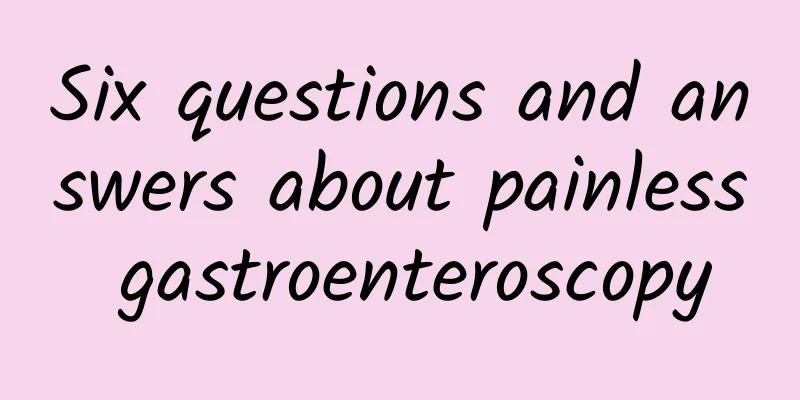Six questions and answers about painless gastroenteroscopy

|
Gastroenteroscopy is also known as the "life-saving examination" of the digestive system because it can directly observe the lesions of the digestive tract and perform pathological biopsy and cytological examination on suspicious lesions, which greatly reduces misdiagnosis and missed diagnosis. Ordinary gastroenteroscopy often causes nausea, vomiting, abdominal distension, abdominal pain and other discomfort symptoms during the operation, which makes many patients afraid of "scope"! Today, I will introduce painless gastroenteroscopy to you and answer some daily confusions. During painless gastroenteroscopy, the anesthesiologist controls the dosage according to the patient's condition and the duration of the examination, closely monitors the changes in vital signs throughout the process, and ensures that your vital signs are stable. The patient will complete the examination and treatment in a sweet dream. For gastroenterologists, under the effect of anesthetic drugs, gastrointestinal motility slows down, which is more conducive to the examination and can also shorten the examination time. The doctor can accurately diagnose the lesion and provide you with the best treatment plan. Question 1: Can everyone have a painless gastroscopy? People with the following conditions should not undergo painless gastroenteroscopy: 1. During severe lung infection or acute upper respiratory tract infection, acute attack of chronic disease (such as asthma). 2. Patients with severe arrhythmia, severe coronary heart disease and myocardial damage, heart failure, stroke in the past 3 months, uncontrolled hypertension, and those who fail the anesthesia assessment. 3. Diseases that can easily cause suffocation, such as bronchitis causing excessive sputum, gastric retention, and acute upper gastrointestinal bleeding causing excessive blood retention in the stomach. 4. Severe snoring and excessive obesity (BMI greater than 30kg/㎡, body mass index (BMI) = weight (kg) / height (m2)), obstructive sleep apnea syndrome, limited neck movement, and those with difficult airway. When the above-mentioned population undergoes painless gastrointestinal endoscopy, the incidence of adverse events will increase significantly. Question 2: Will painless gastroscopy affect memory? During painless gastroenteroscopy, the anesthesiologist will perform intravenous anesthesia, and you will receive the examination and treatment in a comfortable sleep, which is extremely comfortable. The short-acting anesthetics used by the anesthesiologist take effect quickly and disappear quickly. Generally, you can wake up 3-5 minutes after the examination and be discharged after 1-2 hours of observation in the hospital. The impact on memory is minimal. However, it is still recommended that you find a family member or friend to accompany you to ensure your safety and provide necessary support. Remember not to engage in driving, high-altitude operations, etc. within 24 hours. Question 3: Are there any risks with painless gastroscopy? During painless gastroenteroscopy, hypoxemia, hypotension, reflux aspiration, etc. may occur. Patients with underlying diseases such as hypertension and coronary heart disease will also increase the risk of cardiovascular and cerebrovascular accidents. Tell the anesthesiologist the current medical history, past medical history, allergy history, etc. truthfully. Only after the anesthesiologist fully understands the anesthesiologist, can he be well prepared and at ease during the operation, and escort you throughout the whole process. Therefore, preoperative anesthesia evaluation is particularly important. Question 4: Can I still have a painless gastroscopy if I have a cold? Some people have successfully made an appointment for painless gastroenteroscopy, but caught a cold and fever on the day of the examination. Can painless gastroenteroscopy still be performed? If the cold is mild, with only slight nasal congestion and runny nose, a comprehensive assessment can be made by the anesthesiologist and gastroenterologist. If the cold is severe, with symptoms such as cough, sputum, and fever, painless gastroenteroscopy is not recommended. Because inflammation causes the airway to be in a highly responsive state, laryngeal spasm, bronchial spasm, etc. can be easily induced during gastroscopy. In addition, airway secretions increase during a cold, and under anesthesia, sputum cannot be discharged in time, and accumulation in the respiratory tract can easily cause suffocation. It is generally recommended to undergo painless gastroenteroscopy one week after recovery from a cold. Question 5: Can I have a painless colonoscopy when I have my period? Female patients should avoid colonoscopy during menstruation. On the day of the examination, women should not wear makeup so that the anesthesiologist can observe changes in the lips and skin. If you have manicure, please remove the nail polish on at least the middle finger and index finger, because during anesthesia, a finger pulse oximeter needs to be clipped to the finger to monitor oxygen saturation, and the chemical components of the nail polish will interfere with the monitoring. Do not wear jewelry. Question 6: How to stop taking medication before painless colonoscopy? 1. Hypertensive patients should take antihypertensive drugs as prescribed by doctors. If they stop taking the drugs without authorization, once the blood pressure fluctuates sharply during the examination, there may be a risk of cerebrovascular accident. Commonly used drugs for chronic diseases such as lipid-lowering drugs, heart failure drugs, and thyroid disease treatment drugs should be taken 4-5 hours before the examination on the same day. 2. For patients who take anticoagulants such as aspirin, clopidogrel, and warfarin for a long time, abnormal coagulation function may occur, thereby increasing the risk of biopsy bleeding. Before the operation, fully inform the doctor of the medication situation, and the doctor will assess the risk of cardiovascular disease and the risk of bleeding during endoscopic operation to determine whether the medication can be stopped and for how long. 3. If diabetic patients take hypoglycemic drugs or inject insulin in advance, it may cause hypoglycemia. Therefore, it is recommended that diabetic patients stop taking medication once on the day of the examination, and consider taking hypoglycemic drugs or injecting insulin after resuming eating. The above introduces some precautions. I hope you can cope with this examination more easily, so as to detect and treat gastrointestinal diseases early. Painless gastroenteroscopy allows you to reach the "stomach" and "intestine" in one step in your dream, and protect your health. Wei Min, Department of Anesthesiology, Shuangqiao Hospital, Chaoyang District, Beijing [Warm Tips] Follow us, there are a lot of professional medical knowledge here, revealing the secrets of surgical anesthesia for you~ |
>>: Deep sleep and light sleep: exploring the mystery of sleep
Recommend
How to apply for the minority language exam? What are the minority language exams in the college entrance examination?
Many young people want to learn and walk their ow...
Is uterine involution necessary?
The uterus, as a reproductive organ unique to wom...
What are the common methods and folk remedies for treating postpartum bleeding 42 days after delivery?
There are many clinical treatments for bleeding 4...
Do women need to wear underwear under their swimsuits?
Although underwear is very important for women, w...
Many celebrities suffer from respiratory alkalosis, doctors share their real experiences
Recently, many celebrities revealed that they had...
What are the symptoms of premenopausal menstrual disorders?
Women will also experience a series of symptoms b...
The wild food season has begun again! A list of wild vegetables that Chongqing people love to eat. How many have you eaten?
Chongqing is a mountain city with interlaced moun...
How to quickly treat dysmenorrhea
Dysmenorrhea is a symptom that can cause certain ...
What to do if a pregnant woman has facial paralysis
Facial paralysis is also called facial nerve para...
Why do the leaves of Aspidistra turn yellow? How to remedy the yellowing of Aspidistra leaves?
Aspidistra is very common in our daily life. It i...
Pictures of normal menstrual color
We think it is normal for menstrual blood to be d...
What is the best method to whiten and remove spots?
Facial spots and dark yellow skin are something t...
Pregnant after rabies vaccination
I believe everyone should have heard about the ha...









